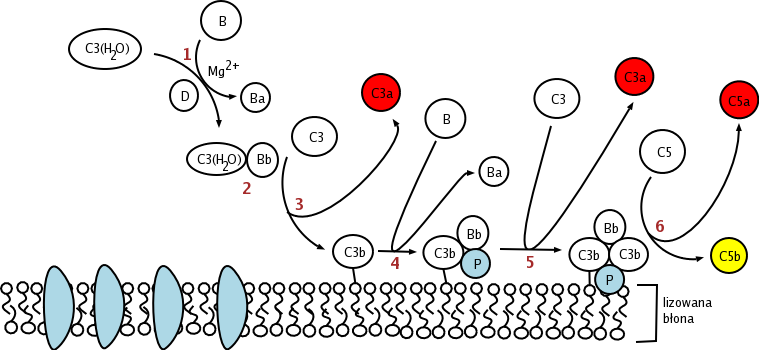Factor D
| complement factor D (adipsin) | |
|---|---|
| File:Factor D.jpg | |
| Identifiers | |
| Symbol | CFD |
| Alt. symbols | DF, PFD |
| Entrez | 1675 |
| HUGO | 2771 |
| OMIM | 134350 |
| RefSeq | NM_001928 |
| UniProt | P00746 |
| Other data | |
| Locus | Chr. 19 p13.3 |
Factor D (EC 3.4.21.46, C3 proactivator convertase, properdin factor D esterase, factor D (complement), complement factor D, CFD, adipsin) a protein which in humans is encoded by the CFD gene.[3] Factor D is involved in the alternative complement pathway of the complement system where it cleaves factor B.
Function
The protein encoded by this gene is a member of the trypsin family of peptidases. The encoded protein is a component of the alternative complement pathway best known for its role in humoral suppression of infectious agents. This protein is also a serine protease that is secreted by adipocytes into the bloodstream. Finally, the encoded protein has a high level of expression in fat, suggesting a role for adipose tissue in immune system biology.[3]

Factor D is a serine protease that stimulates glucose transport for triglyceride accumulation in fats cells and inhibits lipolysis.[4]
Clinical significance
The level of Factor D is decreased[5] in the obese, this reduction may be due to high activity or resistance but exact cause is not totally known.
Structure
All members of the chymotrypsin family of serine proteases have very similar structures. In all cases, including factor D, there are two antiparallel β-barrel domains with each barrel containing six β-strands with the same typology in all enzymes. The major difference in backbone structure between Factor D and the other serine proteases of the chymotrpsin family is in the surface loops connecting the secondary structural elements. Factor D displays different conformations of major catalytic and substrate-binding residues typically found in the chrotrypsin family. These features suggest the catalytic activity of factor D is prohibited unless conformational changes are induced by a realignment.[6]
References
- ↑ PDB: 1HFD
- ↑ Narayana SV, Carson M, el-Kabbani O, Kilpatrick JM, Moore D, Chen X, Bugg CE, Volanakis JE, DeLucas LJ (1994). "Structure of human factor D. A complement system protein at 2.0 A resolution". Journal of Molecular Biology. 235 (2): 695–708. doi:10.1006/jmbi.1994.1021. PMID 8289289.
- ↑ 3.0 3.1 EntrezGene 1675
- ↑ Ronti T, Lupattelli G, Mannarino E (2006). "The endocrine function of adipose tissue: an update". Clinical Endocrinology. 64 (4): 355–65. doi:10.1111/j.1365-2265.2006.02474.x. PMID 16584505.
- ↑ Flier JS, Cook KS, Usher P, Spiegelman BM (1987). "Severely impaired adipsin expression in genetic and acquired obesity". Science. 237 (4813): 405–8. doi:10.1126/science.3299706. PMID 3299706.
- ↑ Volanakis JE, Narayana SV (1996). "Complement factor D, a novel serine protease". Protein Science. 5 (4): 553–64. doi:10.1002/pro.5560050401. PMC 2143395. PMID 8845746.
External links
- Complement+Factor+D at the US National Library of Medicine Medical Subject Headings (MeSH)
This article incorporates text from the United States National Library of Medicine, which is in the public domain.